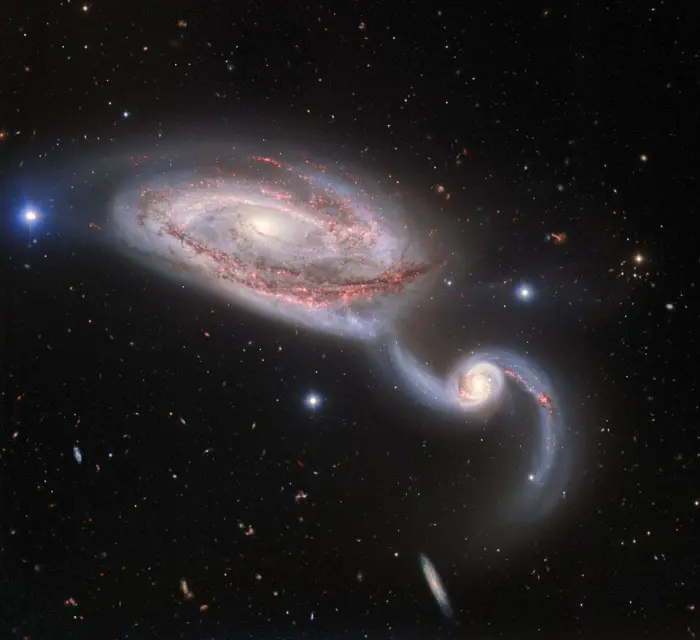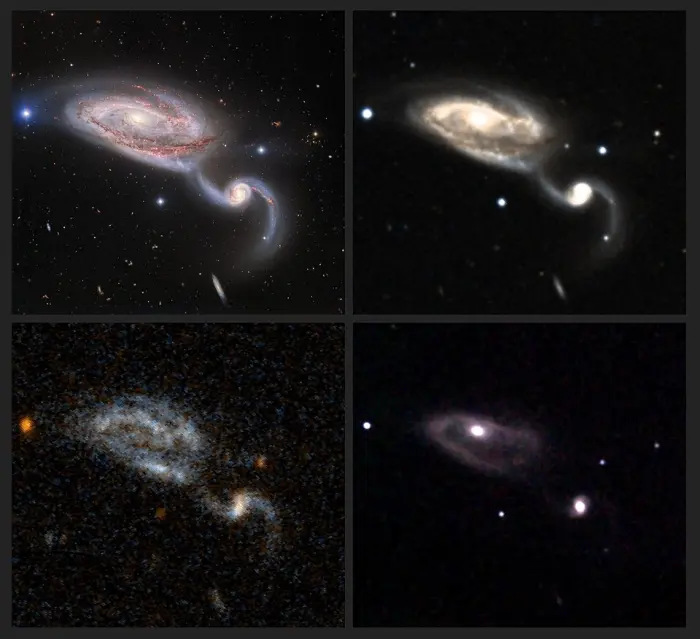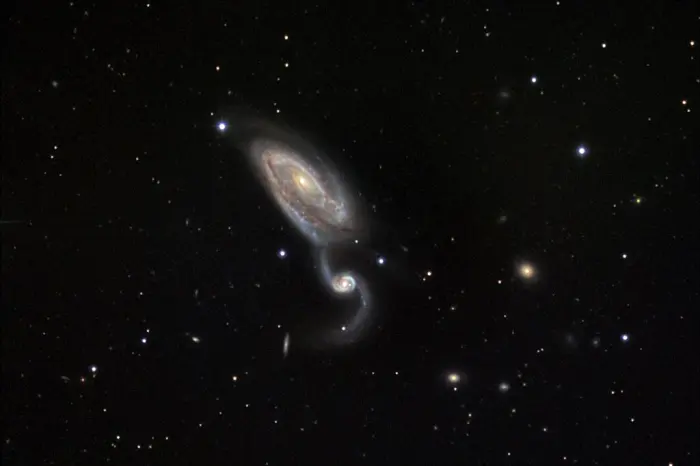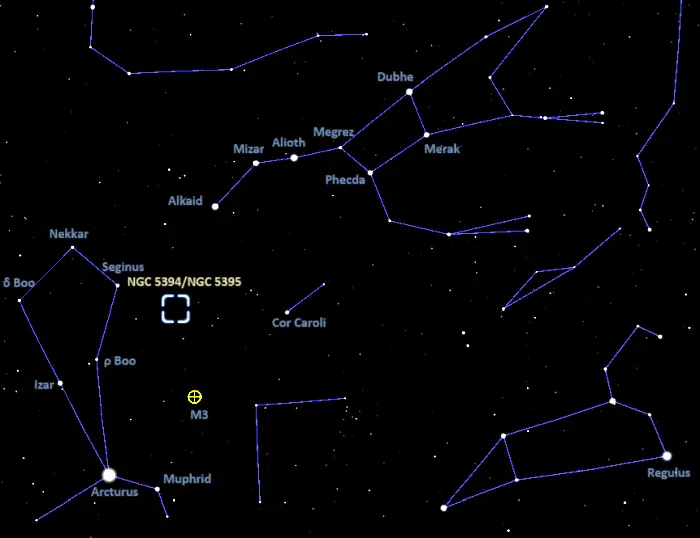The Heron Galaxy (NGC 5394 and NGC 5395) is a pair of interacting galaxies located approximately 176 million light-years away in the constellation Canes Venatici (the Hunting Dogs). The two galaxies are engaged in a slow gravitational dance that will last for several hundred million years or even a few billion years before they merge into a single large galaxy. The colliding pair is catalogued as Arp 84 in the Atlas of Peculiar Galaxies.
The galactic duo was named the Heron Galaxy because it resembles the great blue heron in wait. The larger galaxy NGC 5395 appears as the heron’s body and the smaller NGC 5394 as its head and beak. A more distant galaxy, catalogued as LEDA 2101092 (PGC 2101092) appears as the giant bird’s prey.
Galactic collisions are an important process in galaxy evolution. They typically include multiple successive close passages and complex transformations before the galaxies coalesce into a single galaxy.

Image of the interacting galaxy pair NGC 5394/5 obtained with NSF’s NOIRLab’s Gemini North 8-meter telescope on Hawai’i’s Maunakea using the Gemini Multi-Object Spectrograph in imaging mode. This four-color composite image has a total exposure time of 42 minutes. Image credit: International Gemini Observatory/NOIRLab/NSF/AURA (CC BY 4.0)
Gravitational interaction in merging galaxies triggers multiple bursts of star formation and distorts the galaxies’ shapes. NGC 5394 and NGC 5395 have already collided at least once, and the gravitational forces have pulled out tidal tails of gas and stars from them. Young stellar nurseries appear as reddish regions in images of the pair. NGC 5394 and NGC 5395 will ultimately become a single elliptical or lenticular galaxy.
The larger galaxy NGC 5395 is a spiral galaxy with an apparent magnitude of 12.48 and an angular size of 2.183 by 1.048 arcminutes. It has the morphological type SA(s)b pec. The “pec” suffix refers to the galaxy’s peculiar shape. NGC 5395 appears distorted as a result of interaction with its smaller neighbour. It is receding from Earth at 3,511 km/s.
NGC 5395 has a diameter of about 140,000 light-years. It has a bright central region, two rings and prominent dust lanes. It is classified Seyfert type II galaxy. The galaxy has an active, quasar-like nucleus with a supermassive black hole surrounded by an accretion disk of infalling material.
The more compact and smaller NGC 5394 is a barred spiral galaxy (type SBb) with a diameter of 96,900 light-years. It appears almost face-on and is relatively symmetric, even though its morphology has been modified by the close encounter with its larger neighbour. Its southern spiral arm extends towards NGC 5395. The galaxy lies 175 million light-years away and is receding from us at 3,448 km/s. It has an apparent magnitude of 13.7 in the B band.
NGC 5394 contains prominent regions of ionized hydrogen and is classified as a luminous infrared galaxy (LIRG). It has a luminosity of over 1011 solar luminosities and emits more energy in the infrared band than at all the other wavelengths combined. The high luminosity of luminous infrared galaxies typically comes from star forming activity and the presence of an active galactic nucleus (AGN).

This montage illustrates how the Aladin Lite exploration tool can be used on the NOIRLab website to view and compare images of the same astronomical object, in different wavelengths of light and from different observatories. These four panels show a pair of interacting galaxies called NGC 5394 and NGC 5395. The images are from Gemini North taken in visible light (upper left), the Digitized Sky Survey also taken in visible light (upper right), GALEX (lower left) taken in ultraviolet light, and 2MASS taken in infrared light (lower right). Credit: International Gemini Observatory/NOIRLab/NSF/AURA/Digitized Sky Survey/GALEX/NASA/2MASS/IPAC/Caltech/University of Massachusetts (CC BY 4.0)
Facts
The colliding galaxies NGC 5394 and NGC 5395 were discovered by the German-born British astronomer Sir William Herschel on May 16, 1787. Herschel spotted the galaxies in his 18.7-inch reflector from Slough, England, and catalogued them as I 190 and I 191.
The galaxies are included in American astronomer Halton Arp’s Atlas of Peculiar Galaxies as Arp 84. They are catalogued as “spiral galaxies with large high surface brightness companions.” Halton Arp described NGC 5395 as a spiral galaxy with a high surface luminosity companion at the end of one of its spiral arms.
In 1993, A. M. Garcia of the Lyon Observatory in France proposed that NGC 5394 and NGC 5395 were members of the NGC 5395 Group of galaxies, which also included NGC 5341, NGC 5351, and UGB 8806. The galaxy group is also catalogued as LGG 366.
The spiral galaxy NGC 5395 hosted a supernova, SN 2000cr, discovered in June 2000. SN 2000cr was spotted northeast of the galactic nucleus of NGC 5395 and shone at magnitude 17. It was classified as a type Ic supernova, caused by the core collapse of a massive star that had lost most of its helium.
The smaller barred spiral NGC 5394 hosted a supernova observed more recently. SN 2020 aaxs was detected on November 25, 2020, and classified as a type Ib supernova, triggered by stellar core collapse. The supernova had an apparent visual magnitude of 17.
The Heron Galaxy appears similar to the fainter and more distant barred spiral galaxy NGC 646 in the southern constellation Hydrus. Like the Heron, NGC 646 has a long tidal tail of stars and gas pulled out due to interaction with a smaller neighbour.

These two interacting spiral galaxies are located about 160 million light years away in the constellation Canes Venatici. It is thought that they have already collided once and are currently recoiling. This image was taken as part of Advanced Observing Program (AOP) program at Kitt Peak Visitor Center during 2014. Credit: KPNO/NOIRLab/NSF/AURA/Doug Matthews and E. J. Jones/Adam Block (CC BY 4.0)
Location
The Heron Galaxy lies in the relatively faint constellation Canes Venatici (the Hunting Dogs), near the border with Boötes (the Herdsman). It appears along the imaginary line extended from Alkaid, the star at the end of the Big Dipper’s handle, to the bright Arcturus in Boötes. The colliding pair lies just south of the line connecting Cor Caroli, the brightest star in Canes Venatici, and Seginus in Boötes. Cor Caroli is the brightest star just below Alkaid in the Big Dipper’s handle and Seginus is part of the Kite, an asterism that dominates the Herdsman constellation.
The easiest way to find the galaxies is to draw a line from Nekkar, the star at the top of the Kite, through Seginus and extend it by the same distance as that between the two stars.

The location of the Heron Galaxy (NGC 5394 and NGC 5395), image: Stellarium
The galaxy pair is best seen in larger telescopes at high magnification.
At declination 37° N, NGC 5394 and NGC 5395 never rise for observers south of the latitude 53° S and are best seen from the northern hemisphere.
The best time of the year to observe the Heron Galaxy and other deep sky objects in Canes Venatici is during the month of May, when the constellation appears higher in the sky in the early evening.
NGC 5394
| Constellation | Canes Venatici (the Hunting Dogs) |
| Object type | Barred spiral galaxy |
| Morphological type | SBb |
| Right ascension | 13h 58m 33.6405096192s |
| Declination | +37° 27′ 12.732147036″ |
| Apparent magnitude | 13.7 |
| Absolute magnitude (V) | 13.12 |
| Surface brightness | 23.78 mag/arcsec2 |
| Apparent size | 1.9’ x 1.3’ |
| Distance | 175 million light-years (53.67 megaparsecs) |
| Redshift | 0.011501 |
| Heliocentric radial velocity | 3,448 km/s |
| Size | 96,900 light-years (29,700 parsecs) |
| Names and designations | Heron Galaxy, NGC 5394, Arp 84, Markarian 1508, Mrk 1508, UGC 8898, LEDA 49739, PGC 49739, VV 48b, KPG 404a, KUG 1356+376A, IRAS 13564+3741, IRAS F13564+3741, 2MASX J13583365+3727124, MCG +06-31-033, CGCG 191-024, WN B1356.4+3740A, CASG 1203, ECO 861, NVSS J135833+372713, PSCz Q13564+3741, CGPG 1356.4+3742, FIRST J135833.6+372712, Z 191-24, Z 1356.4+3742, SDSS J135833.63+372712.7, TGSSADR J135833.4+372711, QDOT B1356252+374139, UZC J135833.7+372713 |
NGC 5395
| Constellation | Canes Venatici (the Hunting Dogs) |
| Object type | Barred spiral galaxy |
| Morphological type | SA(s)b pec |
| Right ascension | 13h 58m 37.9605982608s |
| Declination | +37° 25′ 28.161627744″ |
| Apparent magnitude (V) | 12.48 |
| Apparent magnitude (B) | 13.26 |
| Apparent size | 2.183’ x 1.048’ |
| Distance | 176.8 million light-years (54.22 megaparsecs) |
| Redshift | 0.011711 |
| Heliocentric radial velocity | 3,511 ± 10 km/s |
| Size | 140,000 light-years |
| Names and designations | Heron Galaxy, NGC 5395, UGC 8900, LEDA 49747, PGC 49747, MCG +06-31-034, CGPG 1356.5+3740, ECO 4408, VV 48a, KPG 404b, KUG 1356+376B, 2MASX J13583793+3725284, ZW I 77, SDSS J135837.98+372528.1, SDSS J135837.97+372528.2, Z 191-26, Z 1356.5+3740, UZC J135837.6+372532 |